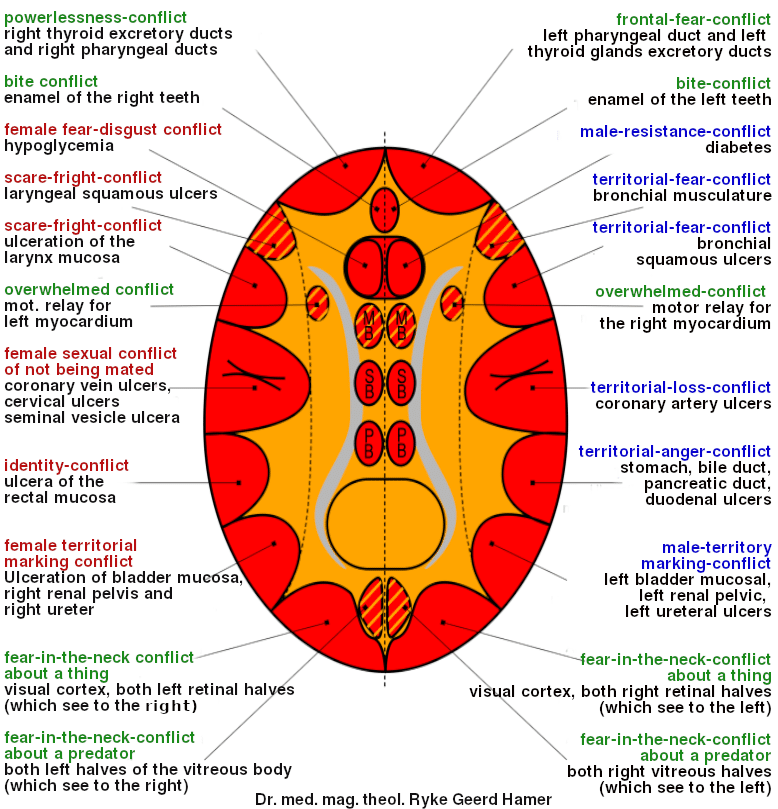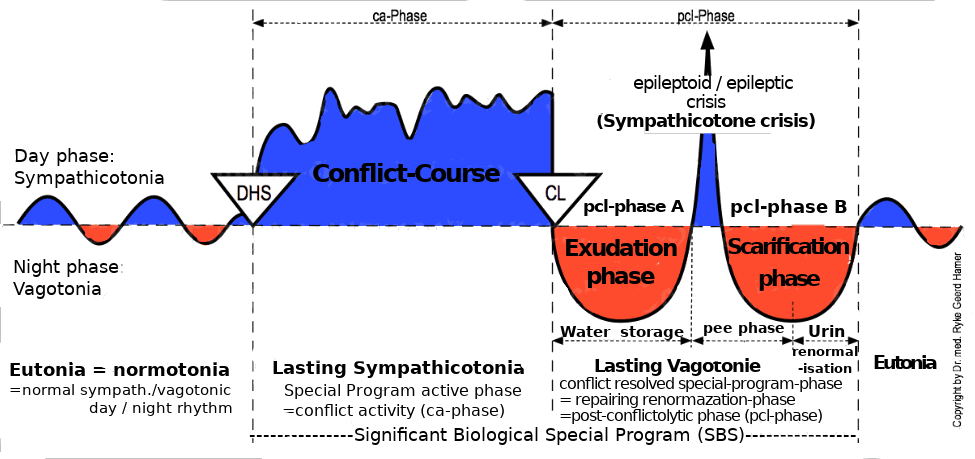In 1981 Germanische Heilkunde introduced The IRON RULE OF CANCER. The Germanische Heilkunde® is an empirical natural science, and it is based on five empirical laws of nature, which can be applied to every so-called disease.

The activation of every so-called disease – which we now understand as a phase of a Sensible Biological Special Program (SBS) – is always a Biological Conflict, a shock experience. This shock, called a DHS, catches the individual unprepared “on the wrong foot” i.e. off balance.
Each conflict has its particular content (visual, auditive, olfactive, tactile and gustative) and this results in associative, i.e., involuntary assignment of thoughts.
The DHS leaves traces in the brain that can be photographed using computed tomography (CT) of the brain. This relay is called a Hamer Focus (HH). Each HH has a very specific conflict content, a specific organ, and a very specific relay in the brain. We can determine whether the conflicts are still in the conflict-active (ca-phase) or already in the healing phase (pcl-phase) and whether cell proliferation or reduction is happening here.
Whether a conflict hits the left or right cerebral hemisphere is determined by the patient’s handedness and the hormonal situation (birth control pills, pregnancy, menopause, schizophrenic constellations, chemotherapy, etc. can affect the hormonal situation). Therefore, the clap test (applause) is a fundamental and indispensable diagnostic criterion to find out on which side of the brain a person basically works. If the right hand is on top, then one is right-handed.
Left-handedness moves the conflict to the opposite side of the brain as compared to the usual right-handedness. However, everything proceeds precisely from then on as the right-handed person’s reverse conflict would. Thus, if a left-handed woman suffers a fright conflict, the Hamer Focus (HH) strikes the right male cerebral hemisphere instead of the left female and at the organic level in the bronchial relay. On the other hand, the right-handed female would have the laryngeal relay affected.
The left-handed male would react with the larynx in a territorial anxiety conflict, and the right-handed male, on the other hand, would react with the bronchial relay.
Organically, both belong to the cerebrum group, i.e., during the conflict-active phase, either ulceration (sensory) or paralysis (motor) occurs in the bronchial or laryngeal relay. This why it is impossible to work at all in Germanische Heilkunde without the knowledge of left or right-handedness.
According to the 2nd Law of Nature, every Sensible Biological Special Program is a two-phase event; every SBS has a conflict-active phase and a conflict-resolved phase if conflict resolution occurs. Any SBS with conflict resolution also has an epileptic or epileptoid crisis. i.e., a turnover point during the healing phase at the lowest point of vagotonia. Epileptic seizure with muscle spasms is only a unique form of epileptic crisis after resolving a motor conflict.

Epilepsy-like, i.e., epileptoid crises, can be found in principle for all SBS, a little bit different in all so-called diseases we know. In contrast, symptomatology, formerly called a disease, is only one phase of a sensible biological special program.
With asthma, besides the handedness of the patient, the epileptoid or epileptic crisis plays a significant role.
Laryngeal asthma, paralysis of the laryngeal muscles in the conflict-active phase, and bronchial asthma paralyzes the bronchial muscles in the conflict-active phase.
In asthma, in principle, the following combination constellations are possible, both in laryngeal asthma, with prolonged inspirium, and in bronchial asthma, with prolonged expirium leading to asthma:
A – In laryngeal asthma – the left-hemispheric laryngeal (laryngeal) muscle relay has an epileptic crisis. Still, somewhere in the right-hemispheric cerebral relay at the same time, there is another Hamer Focus in conflict activity. In this combination constellation, we speak of asthma laryngeals – with prolonged inspirium (inhalation).
B – It is the opposite in bronchial asthma. Here the right-hemispheric bronchial-muscular relay has an epileptic crisis, and in the left-hemispheric cerebral relay, any other Hamer Focus is active at the same time. This is the combination constellation for bronchial asthma – with prolonged expirium (exhalation).
Suppose both the laryngeal motor relay and the bronchial motor relay, have an epileptic crisis. In this case, there is a chronic increased inspirium and expirium, i.e., expiratory and inspiratory asthma laryngeal and bronchial. We call this combination constellation a status asthmaticus, i.e., the patient has acute asthmatic shortness of breath! Nothing happens yet as long as both are “only” in activity.
We speak of so-called spastic bronchitis when only the right-hemispheric bronchial-muscular relay has an epileptic crisis. In the left-hemispheric cerebral relay, no further Hamer Focus is in activity.
In spastic laryngitis (so-called croup), it is again the reverse. Here, the left-hemispheric laryngeal muscle relay has an epileptic crisis, and there is also no activity in the right-hemispheric cerebral relay.
We did not know before why cortisone worked only in a portion of asthma patients. It worked on patients where the conflict on one or on both cerebral hemispheres was in the epileptic crisis. That is, the asthma attack unilaterally or bilaterally represented the epileptic crisis, and with a renal collecting tube SYNDROME often a paradoxical effect of cortisone occurred, that is, even more, increased water retention.
So-called asthmatics are people who often suffer recurrences in the short term. Mostly they have a so-called hanging conflict, which means that the conflict is continuously active, but transformed down (so-called “bank”). The organism has virtually settled with the conflict. Such a patient can live with such a hanging conflict for decades.
However, if the patient suffers yet another cortical conflict, it strikes the opposite cerebral hemisphere, and the patient is instantly in a so-called schizophrenic constellation. However, little conflict load is built up in this schizo constellation.
We can understand some recurrences only if we have conscientiously figured out all the splints that have co-occurred with the DHS. Tracks are additional conflict aspects or additional perceptions at the moment of the DHS. Humans and animals notice in the second of the DHS, even without being aware of it, the accompanying circumstances (optical, acoustic, olfactory, or tactile). In a flashlight snapshot, they keep these records also practically for life. If one of the accompanying circumstances occurs again, then the whole conflict can recur as a so-called recurrence. This means that one always moves up from such a side track to the whole track. Hence, the name splint.
However, each conflict recurrence does not come insidiously, but only with a renewed DHS, whereby the recurrence DHS does not have to have the emotional strength as the first time.
Allergies that we can detect with our allergy tests are always “second-strikes” connected with a DHS. From this, you can see how important it is always to go back to the DHS to visualize precisely the overall situation.
For example a patient suffered from occasional asthma attacks since childhood. Eventually, she was diagnosed with a cat allergy, which was thought to cause the attacks. Nevertheless, the patient was attracted to cats, which she liked to pet from time to time. It was remarkable that she rarely suffered an asthma attack while petting them. On the other hand, she had attacks when she had not been in contact with a cat at all.
When she finally went on a conflict search, she was surprised to find that she only reacted to black cats that were also of a specific size or if she happened to see a dead animal on the street. Eventually, as she researched further, she found out that she had apparently witnessed her beloved black kitten as a toddler, to whom she was very attached, being run over and crushed by a car in the street (DHS).
She had consciously had no memory of the event itself, which was now more than 20 years later. Nevertheless, she reacted with a recurrent DHS every time she saw or stroked a black cat that was a very specific size or when she saw a dead animal lying on the road that had been run over (track).
The DHS is proof of how precisely the psyche correlates with conflict, the brain with Hamer Focus, and the organ with our tracks. With the tools of the trade, i.e., with knowledge of the 5 Biological Laws of Nature of Germanische Heilkunde®, and the knowledge of the respective typical symptoms of the course on the three levels of psyche – brain – organ, it is now possible for the first time in medicine to work causally and reproducible in a meaningful way.
Copyright Dr. Hamer
Translated: John Holledauer
Copyright © 2024 by GHk Online Service, LLC
| Cookie | Duration | Description |
|---|---|---|
| cookielawinfo-checkbox-analytics | 11 months | This cookie is set by GDPR Cookie Consent plugin. The cookie is used to store the user consent for the cookies in the category "Analytics". |
| cookielawinfo-checkbox-functional | 11 months | The cookie is set by GDPR cookie consent to record the user consent for the cookies in the category "Functional". |
| cookielawinfo-checkbox-necessary | 11 months | This cookie is set by GDPR Cookie Consent plugin. The cookies is used to store the user consent for the cookies in the category "Necessary". |
| cookielawinfo-checkbox-others | 11 months | This cookie is set by GDPR Cookie Consent plugin. The cookie is used to store the user consent for the cookies in the category "Other. |
| cookielawinfo-checkbox-performance | 11 months | This cookie is set by GDPR Cookie Consent plugin. The cookie is used to store the user consent for the cookies in the category "Performance". |
| viewed_cookie_policy | 11 months | The cookie is set by the GDPR Cookie Consent plugin and is used to store whether or not user has consented to the use of cookies. It does not store any personal data. |
You’ll be informed by email when we post new articles and novelties. In every email there is a link to modify or cancel your subscription.